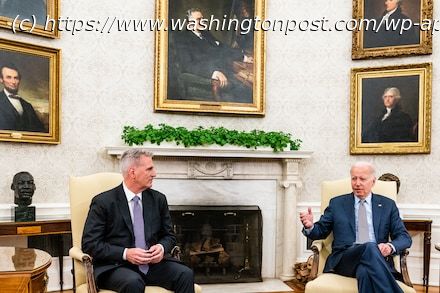Hardliners were vocal in the lead-up to the debt deal. But the final product shows the ongoing power of the center.
For weeks, conservative Republicans warned House Speaker Kevin McCarthy not to back down from sweeping spending cuts, saying anything else would be an unforgivable betrayal. Liberals implored President Biden to abandon the debt ceiling talks altogether, insisting the Constitution enabled him to simply ignore Republican demands.
But in the end, the two leaders opted for a middle-of-the-road settlement, aiming to coalesce center-right and center-left lawmakers around the idea that an imperfect deal was preferable to a historic default that could devastate the economy. It was the first significant test for the Biden-McCarthy era of divided government, and if a theme emerged, it was the unmistakable reassertion of the political center.
“Both sides were initially sounding very ardent about an inflexible position,” said presidential historian Douglas Brinkley. “Yet both sides ultimately blinked — and that is what American politics is all about.”
Biden and McCarthy have each struggled at times to balance governing responsibly with appeasing their party’s base voters. The fire on the right has been especially notable, as McCarthy’s narrow majority includes a significant group that resists compromise and has the power to challenge his speakership. Adding to the drama of the current standoff was the perpetual threat that they could seek to topple the California Republican from his perch.
Yet in the end, the political dealmaking skills that Biden and McCarthy have honed during their decades in Washington have apparently prevailed — to the relief of moderate lawmakers, some of whom had grown anxious about the fast-approaching “X” date of June 5, when the U.S. government was expected to run out of funds.
Members of centrist groups like the Problem Solvers Caucus, the Republican Governance Group and the New Democrat Coalition quickly embraced the Biden-McCarthy deal. On the other hand, conservative Republicans and liberal Democrats were left to grapple with the reality that their votes may not be critical in the tightly divided House.
White House officials involved in the negotiations said Biden believed from the beginning that a bipartisan approach had a higher likelihood of succeeding. The president campaigned for the White House in large part on his ability to bring together the parties in Congress, even at a hyperpartisan moment.
Young, currently the director of the White House Office of Management and Budget, added, “I’ve worked in many divided government situations. I think this is where you would expect a bipartisan agreement to land. It’s just the reality. There’s not unified government. They have ideas. We have to listen to them. We have to talk about it.”
The debt ceiling deal still faces strong opposition from the right and the left, and could still fall apart before June 5.
Partisans lost little time criticizing the agreement and promising to torpedo it. Members of the House Freedom Caucus gathered Tuesday to denounce the agreement, saying it did not go far enough to restrict spending and roll back Biden’s priorities, and pledging to persuade as many Republicans as possible to vote against it.






